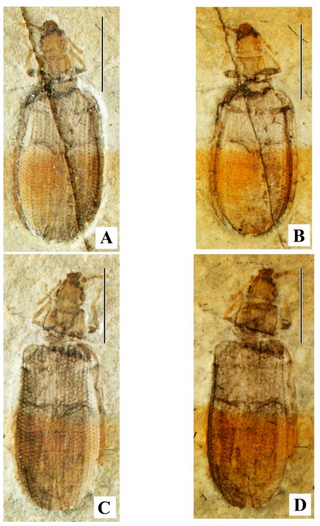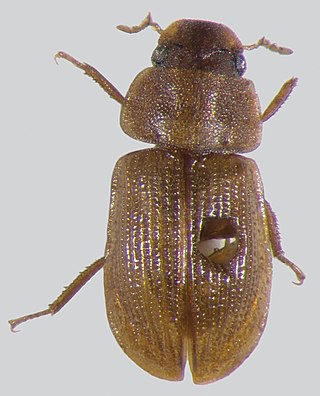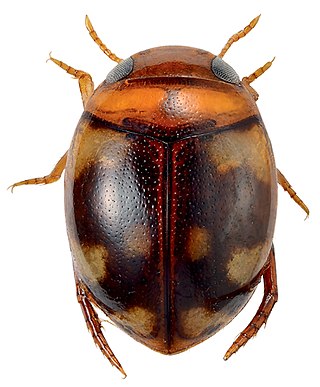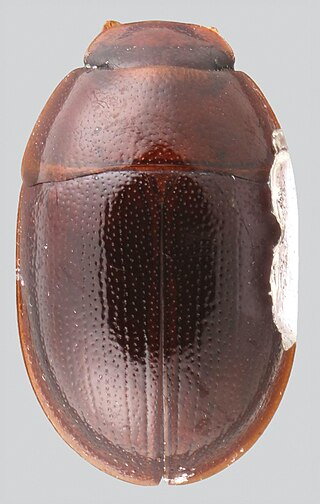
The Blastobasidae are a family of moths in the superfamily Gelechioidea. Its species can be found almost anywhere in the world, though in some places they are not native but introduced by humans. In some arrangements, these moths are included in the case-bearer family (Coleophoridae) as subfamily Blastobasinae. The Symmocidae are sometimes included in the Blastobasidae as subfamily or tribe.

Cebrionini is a tribe of click beetles from the family Elateridae; formerly ranked as a subfamily or family, they are now considered a tribe within the subfamily Elaterinae.
Copelatus taprobanicus is a species of diving beetle endemic to Sri Lanka. It is part of the genus Copelatus in the subfamily Copelatinae of the family Dytiscidae. It was described by Wewalka & Vazirani in 1985.

Chiridopsis punctata is a species of leaf beetles belonging to the family Chrysomelidae.

Orthonevra pictipennis (Loew,1863), the Dusky-veined Mucksucker, is an uncommon species of syrphid fly. It has been observed in North America. O. pictipennis shares much of the same range as O. pulchella, O. nitida and O. feei. Hoverflies get their names from the ability to remain nearly motionless while in flight. The adults are also known as flower flies, for they are commonly found around and on flowers from which they get both energy-giving nectar and protein-rich pollen. Larvae for this genus are of the rat-tailed type. O. pictipennis larvae have not been described.

Gratiana pallidula, the eggplant tortoise beetle, is a species of tortoise beetle in the family Chrysomelidae. It is found in Central America and North America.

Monticupes is an extinct genus of ommatid beetle. The genus is characterised by "moderately oval body, subtriangular or long (subparallelsided) head with large eyes and well raised temples, pronotum carinate and with subexplanate sides, veins well expressed with fused A1 and Cu at apex and their common vein ending on Sc, explanate elytral sides moderately wide and with diffuse small microtubercles, and abdominal ventrites co-planar (abutting)."

Pareuryomma is an extinct genus of ommatid beetle. It is known from three species, P. angustum, P. cardiobasis and P. tylodes, all known from the Aptian aged Yixian Formation of China. The genus was first described in 2012, and formerly included the species Pareuryomma ancistrodonta from the Middle Jurassic Jiulongshan Formation, China, which was transferred to the genus Omma in 2020. The species P. angustum was formerly thought to be part of Brochocoleus. The genus is characterised by "slender body, long and subparallelsided or slightly narrowed head with moderately prominent eyes and more or less prominent temples, narrow pronotum with more or less explanate lateral carinae, elytra with the veins more or less well expressed and independently ending on Sc, large cells more or less arranged in rows on disc and moderately widely explanate sides of the elytra, and abdominal ventrites co-planar."

Acidocerus aphodioides is a species of water scavenger beetle in the family Hydrophilidae. It is the only species in the genus Acidocerus. It is known only from Mozambique.
Silvanoprus longicollis, is a species of silvan flat bark beetle found in India, Sri Lanka, Malaysia, Java, China, Japan, Madagascar and East Africa.

Hydaticus pacificus, is a species of predaceous diving beetle found in South and South East Asia.

Microdytes maculatus, is a species of predaceous diving beetle found in India, Thailand, Southern Andaman Islands, Sri Lanka, China, Thailand, Laos and Myanmar.
Astycus armatipes, is a species of weevil found in Sri Lanka.
Astycus immunis, is a species of weevil found in Sri Lanka.
Arixyleborus mediosectus, is a species of weevil found in India, Sri Lanka, Cambodia, Myanmar, Philippines, Malaysia, Indonesia: Sumatra and Vietnam.
Jauravia limbata, is a species of lady beetle native to India, Sri Lanka, Nepal and Bhutan.
Aspidimorpha dorsata, is a species of leaf beetle widely distributed in South Asia and South East Asia.
Notosacantha vicaria is a species of leaf beetle native to India, and Sri Lanka.

Quadriops is a Neotropical genus of water scavenger beetle in the family Hydrophilidae represented by six described species.











